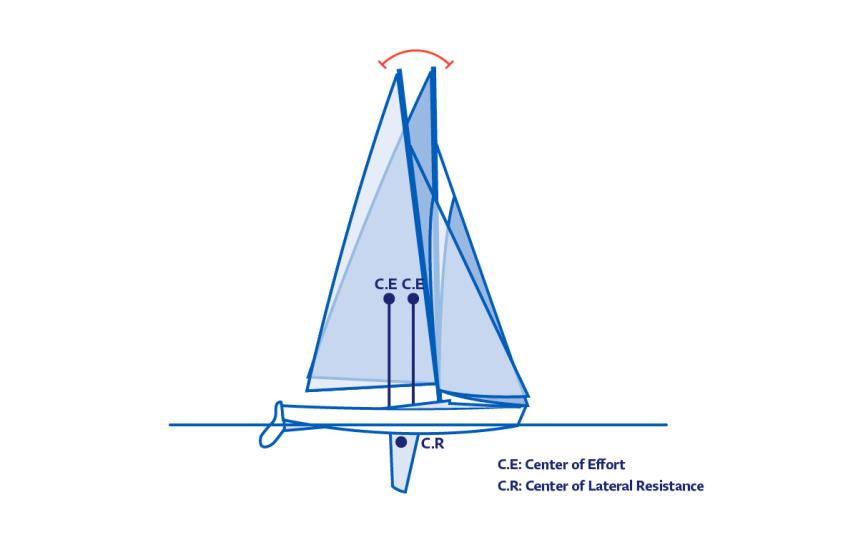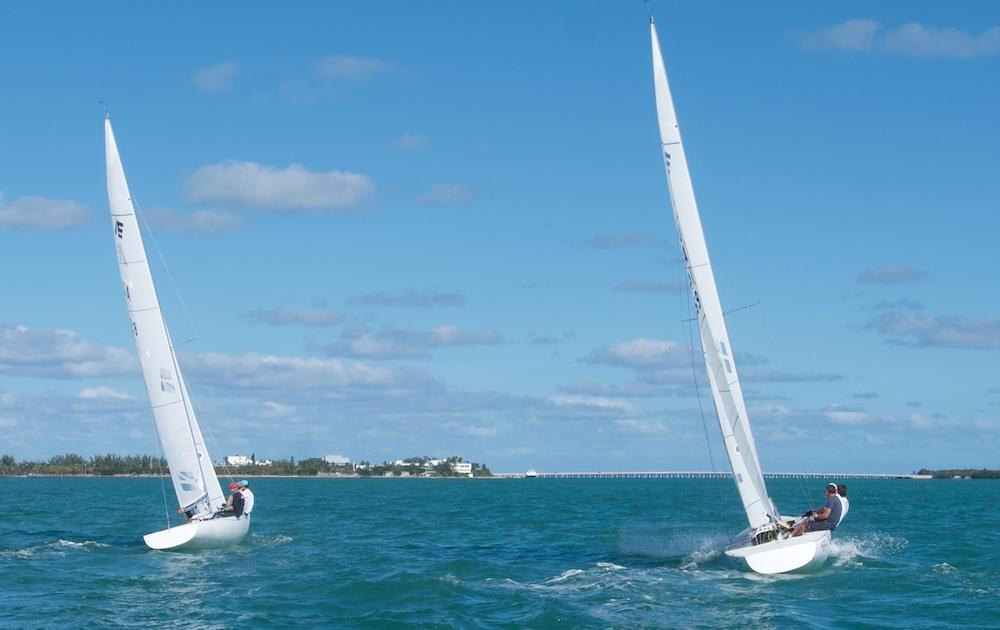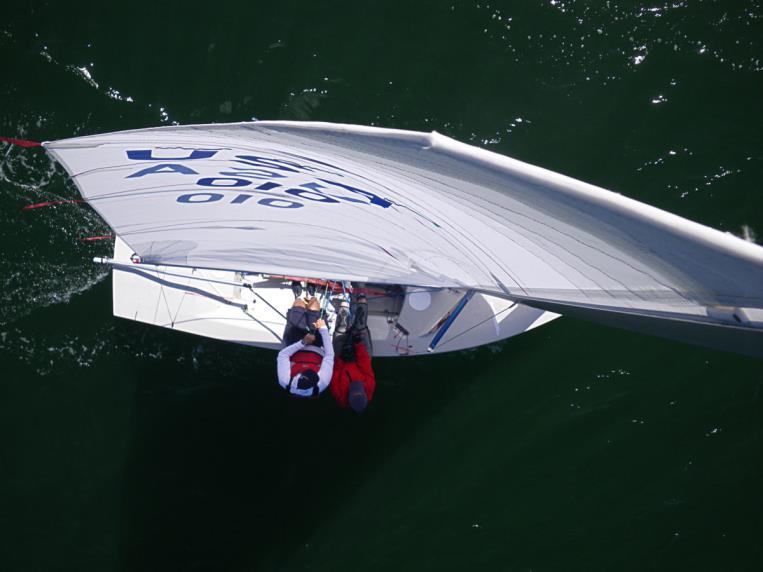Achieving Balance in your Sailplan
North Expert Skip Dieball Offers Three Ways To Improve Helm Balance From Sails And Foils, And Increase Your Speed Upwind
Racing dinghies and keelboats alike, a key to speed is maintaining a balanced helm upwind. All sailboats have a different feel when you steer them. Some have a naturally heavy windward helm, and some have very neutral or sometimes even leeward helm. All things being equal, your goal is to sail with little windward helm, which makes the boat more enjoyable to sail and, more importantly faster, through the water. To achieve that balanced state, you have a lot of tools above the rails that you can use.
Most popular one-design boats have a North Sails tuning guide for your particular design. These guides help you get the boat set up correctly to achieve a nice helm balance. Tuning guides give great suggestions on shroud tension, forestay length, mast-butt position, etc. All play into getting the boat in the ballpark for good performance.
To go the next step, let’s explore three key factors: Your mast rake (and centerboard position if you have one); Your sail trim and angle of heel; Your sailing angle of attack relative to the wind direction.

On any sailboat, when the center of effort in the sails (CE) aligns with the center of lateral resistance
(CR) of the boat and foils, the helm will balance. If the CE moves aft, windward helm will develop and if it moves forward, leeward helm will be felt.
Balance Mast Rake & Board Position
First, let’s establish what causes helm—the tendency of the rudder to turn toward the wind (weather helm) or away from it (leeward helm). When perfectly balanced, your boat’s Center of Effort (center of the sail plan lift) would be closely aligned with the Center of Resistance (center of the appendage lift). The further the CoE and CoR are from one another, the more helm your boat will naturally have).
As you can see in the illustration, if you have the ability to move the CR or CE, you can get your boat closer to perfect balance. In fact, a little mast rake can go a long way. For example, we’ll lengthen or shorten the forestay on the Etchells as little as 1/4” and the resulting movement aft of the CE will get the boat into a noticeably more balanced helm state. We adjust this for race conditions each day, and make sure we are happy with the adjustment is important before we get to the starting line.
In centerboard boats like the Lightning, Interlake and Finn, you have the ability to adjust your CR through small changes in centerboard position. Generally, you’ll want the centerboard all the way down in light to moderate conditions. This induces necessary helm for the lighter conditions. When you start to get loaded up and have to hike harder to keep the boat tracking, you may consider pulling up the board a little at a time to move the CR more in line with CE, thus reducing the helm. Be sure to create marks or visual indicators of the board position for each condition.
BALANCE TIP #1: Set up your rig to your tuning guide, then create a tuning journal to document settings and correlate to boat feel.

Of these two Etchells, the boat on the left has a firmer main trim, which is causing more heel and thus more helm and creating a tighter angle of attack. The boat on the right has a more twisted look to its sails that yields a flatter boat and less point.
Rig and centerboard adjustments have a big effect on the helm, but if you are stubborn, like me, you’ll want to do everything else you can first. As I prepare for a race, my team and I will sail upwind and focus in on how the boat is set up and going through the water. We’ll talk about helm and boat set-up, but what I like to discuss as well is how the sails are set up and whether we feel we can hike the boat down.
Sail trim has such a huge effect on how the boat feels, and we want to be sure that we have a good range of trim as we go upwind through gusts and lulls. Markings on the spreader, sheets, deck, etc. all give us a quick reference points and let us get the sails set in the ballpark.
If the boat is too powered up, I’ll look to make some adjustments to the sheets to see if easing gives the boat a nice feel, or if in easing, the boat becomes too inefficient going upwind (I.e. if the sheets are too eased and we’re not pointing well enough). If we have to ease too much to get the boat tracking, we’ll depower through backstay, boom vang, traveler or other controls to flatten out the sails. Knowing the range of these controls and trim is super important.
BALANCE TIP #2: Learn the controls to depower and balance the helm—but don’t forget to hike hard first!
Minimizing heel angle is critical to maintaining helm balance, as extra heel increases windward helm, and one thing that rarely fails in getting the boat to track with good helm is hiking. Believe me, I’ve searched for ways to sail fast while not hiking hard—it doesn’t work! Make sure when you are setting your boat up that you and your team give the boat all the force you can in terms of hiking. That, for me, adds to the range of sail trim and control.
Refine Your Angle of Attack
The angle of attack is the angle you sail the boat upwind. As we all know, there’s a range in this angle of attack. It is also referred to as the “groove”. Some boats have a wide groove, meaning that you can steer a wider course upwind to achieve the same helm or feel. Some boats have a very narrow groove.
Ideally, you’ll want a groove that will be forgiving enough to steer around big waves, while sailing a little tighter and higher for short stretches.
How you attack the breeze and the edges of this groove will affect the helm greatly. The lower you sail (fat), the more the boat will likely heel and the more helm you’ll have. The higher you sail (pinchy) the less helm you will have and ultimately, you’ll slow down and lose flow over both the sail plan and the keel/centerboard/rudder.
Your goal should be to rein in the range of the angle of attack so that you have a nice groove and sail efficiently upwind at a consistent angle of heel. If the helm/trim are causing you to steer too pinched up, then adjustments have to be made to get you into a part of the groove that is more efficient.
BALANCE TIP #3: Practice early in the season to get a handle on your angle of attack while sailing.


